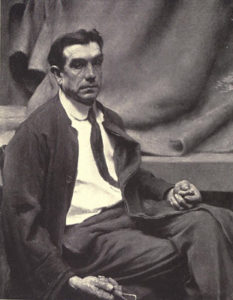 Bela Lyon Pratt was born on December 11, 1876 in Norwich Connecticut. His parents were Sarah Whittlesey and George Pratt, a Harvard educated lawyer. Both of his parents were members of families that placed a high value on education. Sarah’s father, Oramel Whittlesey a highly skilled piano maker, was the founder of the first accredited music school in the nation, Music Vale Seminary in Salem, CT. He also served as a state senator.
Bela Lyon Pratt was born on December 11, 1876 in Norwich Connecticut. His parents were Sarah Whittlesey and George Pratt, a Harvard educated lawyer. Both of his parents were members of families that placed a high value on education. Sarah’s father, Oramel Whittlesey a highly skilled piano maker, was the founder of the first accredited music school in the nation, Music Vale Seminary in Salem, CT. He also served as a state senator.
Bela Pratt’s natural artistic abilities became apparent at an early age. At the age of sixteen he began studying at the Yale University School of Fine Arts. Following four years of formal training at Yale, he entered the Art Students League in New York City where he met Augustus Saint-Gaudens who became his lifelong mentor. He moved briefly to Paris to continue his training at the Ecole des Beaux-Arts where he won several medals for his works of sculpture.
Returning to New York in 1892 he resumed his work at Saint-Gaudens studio where he completed work on two massive sculptures that were exhibited at the World’s Columbian Exposition in 1893 in Chicago. The sculptures named The Genius of Navigation and Genius of Discovery both received great public and critical acclaim and effectively launched Pratt’s career. During this same time period he began what would become a twenty-five-year tenure as a teacher at the Museum of Fine Arts in Boston.
In addition to his teaching duties during the late nineteenth and early twentieth centuries, Pratt remained prolific in his creation of innovative sculptures designed for public spaces. Meanwhile Augustus Saint-Gaudens had contracted with the U.S. Mint to create a fresh design for circulating coinage. Pratt assisted his mentor on this redesign project and succeeded him as head of the project with Saint-Gaudens untimely death in 1907. Pratt’s high relief design with an American Indian Chief in full headdress on one side of the coin and a Bald Eagle with a clutch of arrows and an olive branch on the other was boldly different from the Lady Liberty design of the earlier coins produced by the U. S. Mint.
Despite various health issues, Pratt’s creative output remain undiminished during the last decade of his life. He created numerous commissioned sculptures that became prominent public landmarks throughout the nation. He passed away from heart disease in May of 1917 at the age of forty-nine.
To view images of some of Bela Lyon Pratt’s works of sculpture, visit the Otis Library’s Flickr site for historical photographs.
